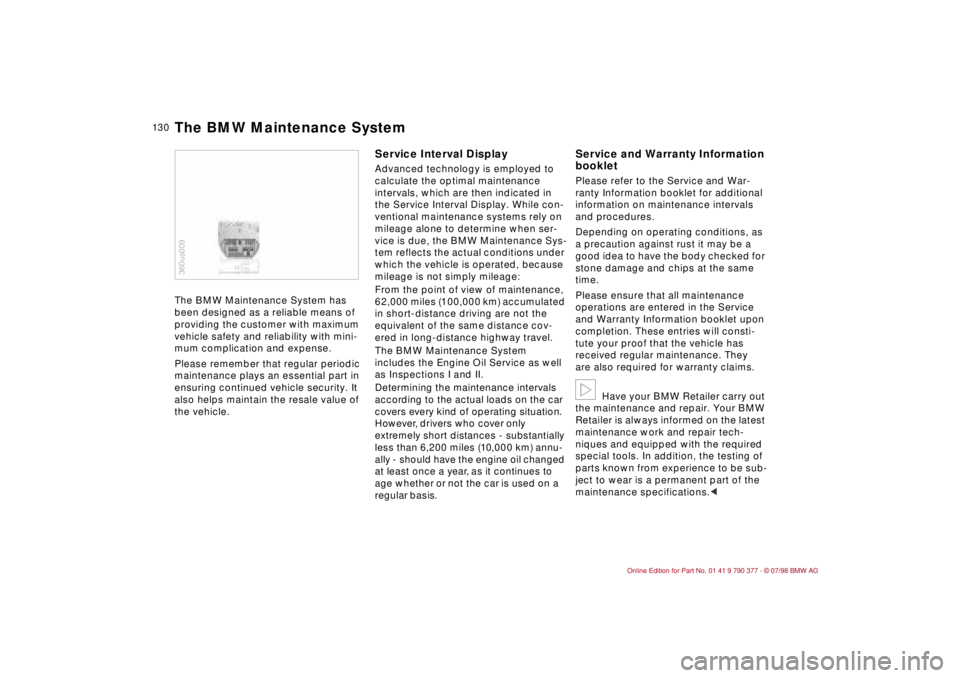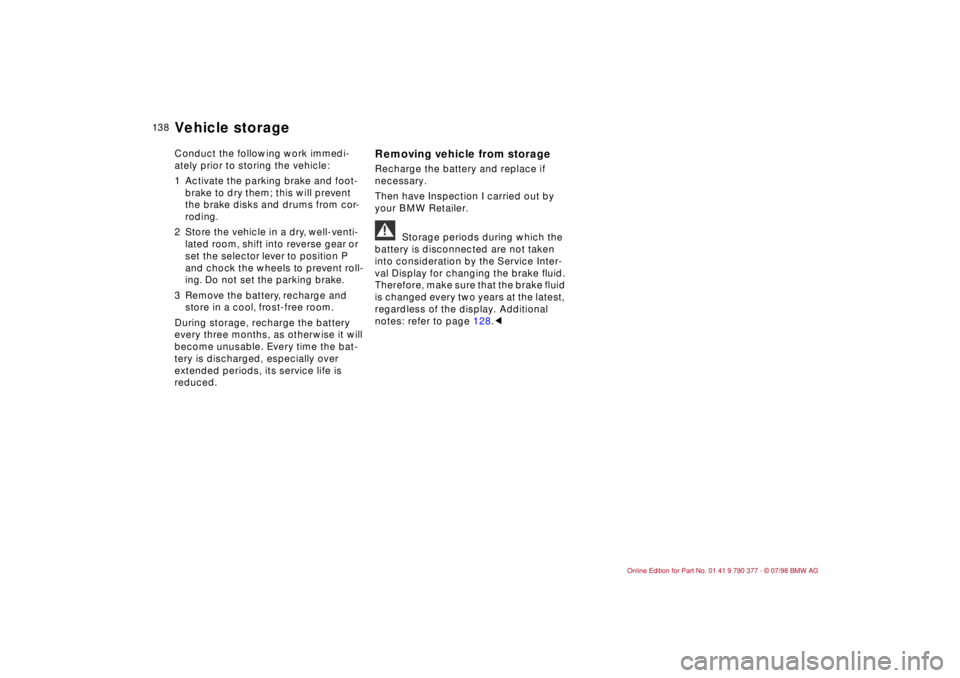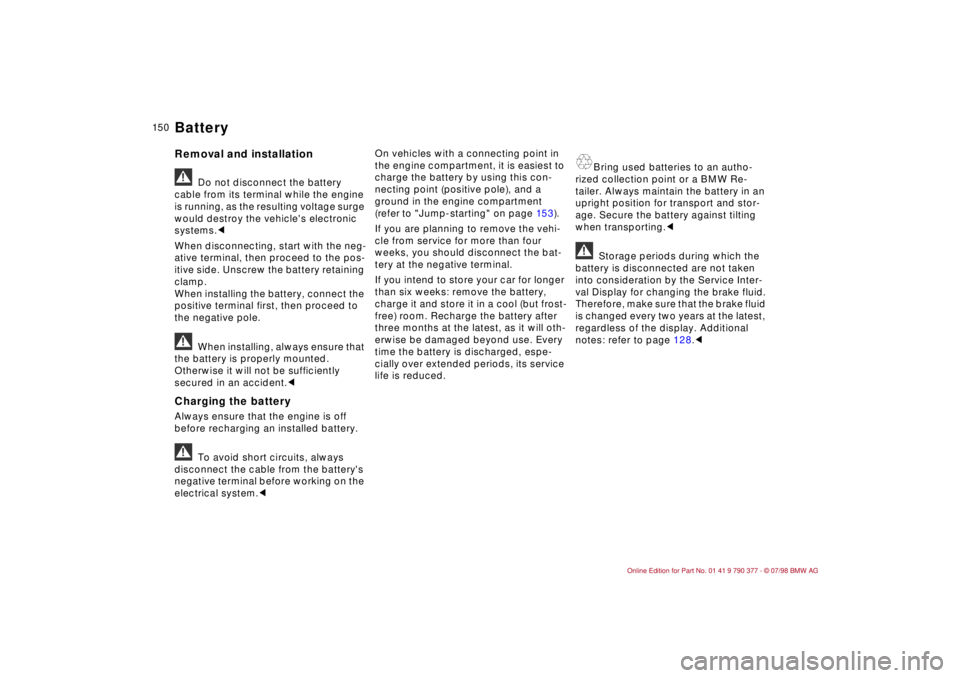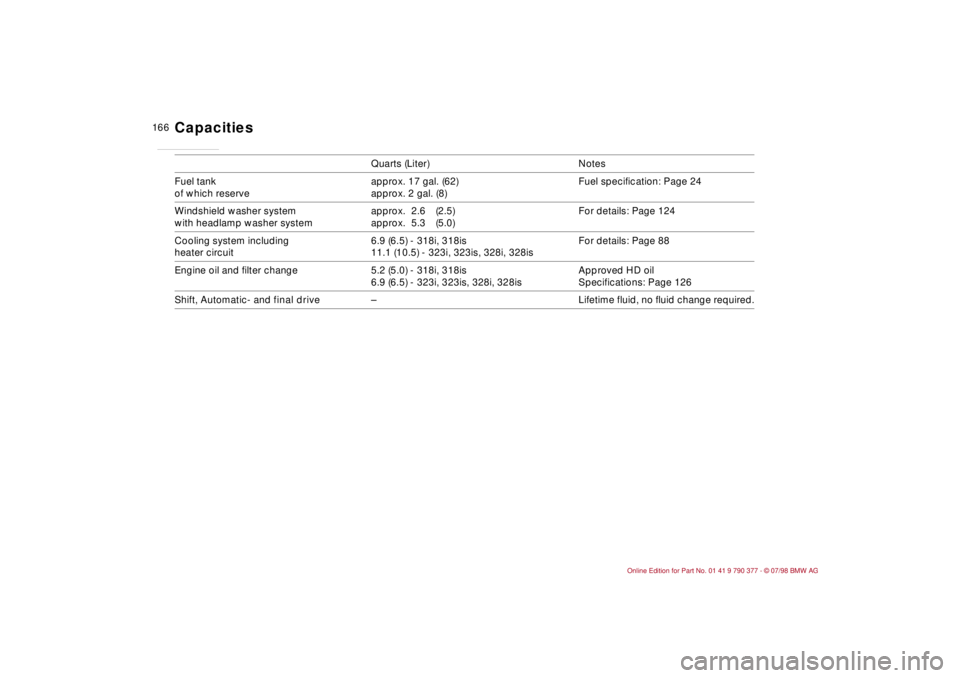1998 BMW CONVERTIBLE change time
[x] Cancel search: change timePage 131 of 179

13 0
The BMW Maintenance System has
been designed as a reliable means of
providing the customer with maximum
vehicle safety and reliability with mini-
mum complication and expense.
Please remember that regular periodic
maintenance plays an essential part in
ensuring continued vehicle security. It
also helps maintain the resale value of
the vehicle.
Service Interval DisplayAdvanced technology is employed to
calculate the optimal maintenance
intervals, which are then indicated in
the Service Interval Display. While con-
ventional maintenance systems rely on
mileage alone to determine when ser-
vice is due, the BMW Maintenance Sys-
tem reflects the actual conditions under
which the vehicle is operated, because
mileage is not simply mileage:
From the point of view of maintenance,
62,000 miles (100,000 km) accumulated
in short-distance driving are not the
equivalent of the same distance cov-
ered in long-distance highway travel.
The BMW Maintenance System
includes the Engine Oil Service as well
as Inspections I and II.
Determining the maintenance intervals
according to the actual loads on the car
covers every kind of operating situation.
However, drivers who cover only
extremely short distances - substantially
less than 6,200 miles (10,000 km) annu-
ally - should have the engine oil changed
at least once a year, as it continues to
age whether or not the car is used on a
regular basis.
Service and Warranty Information
bookletPlease refer to the Service and War-
ranty Information booklet for additional
information on maintenance intervals
and procedures.
Depending on operating conditions, as
a precaution against rust it may be a
good idea to have the body checked for
stone damage and chips at the same
time.
Please ensure that all maintenance
operations are entered in the Service
and Warranty Information booklet upon
completion. These entries will consti-
tute your proof that the vehicle has
received regular maintenance. They
are also required for warranty claims.b
Have your BMW Retailer carry out
the maintenance and repair. Your BMW
Retailer is always informed on the latest
maintenance work and repair tech-
niques and equipped with the required
special tools. In addition, the testing of
parts known from experience to be sub-
ject to wear is a permanent part of the
maintenance specifications.c
360us009The BMW Maintenance System
Page 133 of 179

13 2
Exterior finishTo provide effective corrosion protec-
tion, multilayer paintwork is applied at
the factory. Cataphoretic immersion
priming techniques are supplemented
using special body-cavity protectants,
with the application of specially-devel-
oped and extensively tested materials.
The entire underbody is sprayed with a
flexible PVC layer before final compre-
hensive application of a wax-based
protectant.
Regular maintenance makes an impor-
tant contribution to maintaining the
safety and value of your vehicle.
Increasing awareness of the effects of
harmful environmental factors on vehi-
cle finishes have led paint and vehicle
manufacturers to initiate ongoing pro-
grams designed to further improve the
durability of their finishes. Despite the
high quality of the resulting products,
local and regional factors can still have
a negative effect on your car's paint-
work. These should guide you in deter-
mining the frequency and extent of your
efforts to maintain the vehicle finish.
Depending upon material and type of
impact (perforation of paint layer), phys-
ical stresses from sand, road salt,
gravel, etc. can cause corrosion to start extending beneath the finish, starting at
the point of impact.
Road dirt, tar spots, dead insects, ani-
mal droppings (strong alkali effect) and
tree excretions (resins and pollen) all
contain substances capable of causing
damage when allowed to remain on
your car's finish for any period of time
(spots, etching, flaking, separation in
the top coat).
In industrial areas, deposits from ßy ash,
lime, oily soot, sulphur dioxide in pre-
cipitation (acid rain) and other environ-
mental pollutants will damage the car's
surface (usually limited to the external
horizontal surfaces) unless adequate
protection is provided.
In coastal regions, high levels of atmo-
spheric salt and humidity promote cor-
rosion.
In tropical zones, temperatures of over
100 5F (approx. 406) in the shade pre-
vail, in addition to heavy ultraviolet radi-
ation and high humidity. Under those
circumstances, light-colored paints
reach temperatures of up to 175 5F
(approx. 806) and dark paints up to
250 5F (approx. 1206).
Caring for the vehicle finishAs a precaution against damage result-
ing from exposure to aggressive sub-
stances, we recommend that you wash
the car weekly when it is used in an
area with high levels of air pollution or
aggressive natural substances (tree
resin, pollen).
Remove particularly aggressive sub-
stances immediately in order to prevent
changes to, and discoloration of, the
paint. Such substances are e.g., gaso-
line spilled during refueling, oil, grease,
brake fluid and bird droppings.
Any contamination remaining on the
surface of the vehicle will be especially
conspicuous after washing. Use clean-
ing fluid or alcohol with a clean cloth or
cotton pad to remove. You can use tar
remover to remove any spots on the fin-
ish of the vehicle, but should never
apply it or any other aggressive
cleanser to lenses or headlamp covers.
These areas should then be waxed to
maintain protection.b
A full range of car-care products is
available from your BMW Retailer.c
Caring for your car
Page 139 of 179

13 8
Conduct the following work immedi-
ately prior to storing the vehicle:
1 Activate the parking brake and foot-
brake to dry them; this will prevent
the brake disks and drums from cor-
roding.
2 Store the vehicle in a dry, well-venti-
lated room, shift into reverse gear or
set the selector lever to position P
and chock the wheels to prevent roll-
ing. Do not set the parking brake.
3 Remove the battery, recharge and
store in a cool, frost-free room.
During storage, recharge the battery
every three months, as otherwise it will
become unusable. Every time the bat-
tery is discharged, especially over
extended periods, its service life is
reduced.
Removing vehicle from storageRecharge the battery and replace if
necessary.
Then have Inspection I carried out by
your BMW Retailer.a
Storage periods during which the
battery is disconnected are not taken
into consideration by the Service Inter-
val Display for changing the brake fluid.
Therefore, make sure that the brake fluid
is changed every two years at the latest,
regardless of the display. Additional
notes: refer to page 128.c
Vehicle storage
Page 151 of 179

15 0
Removal and installationa
Do not disconnect the battery
cable from its terminal while the engine
is running, as the resulting voltage surge
would destroy the vehicle's electronic
systems.c
When disconnecting, start with the neg-
ative terminal, then proceed to the pos-
itive side. Unscrew the battery retaining
clamp.
When installing the battery, connect the
positive terminal first, then proceed to
the negative pole.
a
When installing, always ensure that
the battery is properly mounted.
Otherwise it will not be sufficiently
secured in an accident.c
Charging the battery Always ensure that the engine is off
before recharging an installed battery. a
To avoid short circuits, always
disconnect the cable from the battery's
negative terminal before working on the
electrical system.cOn vehicles with a connecting point in
the engine compartment, it is easiest to
charge the battery by using this con-
necting point (positive pole), and a
ground in the engine compartment
(refer to "Jump-starting" on page 15 3).
If you are planning to remove the vehi-
cle from service for more than four
weeks, you should disconnect the bat-
tery at the negative terminal.
If you intend to store your car for longer
than six weeks: remove the battery,
charge it and store it in a cool (but frost-
free) room. Recharge the battery after
three months at the latest, as it will oth-
erwise be damaged beyond use. Every
time the battery is discharged, espe-
cially over extended periods, its service
life is reduced.
A
Bring used batteries to an autho-
rized collection point or a BMW Re-
tailer. Always maintain the battery in an
upright position for transport and stor-
age. Secure the battery against tilting
when transporting.c
a
Storage periods during which the
battery is disconnected are not taken
into consideration by the Service Inter-
val Display for changing the brake fluid.
Therefore, make sure that the brake fluid
is changed every two years at the latest,
regardless of the display. Additional
notes: refer to page 128.c
Battery
Page 167 of 179

16 6
Quarts (Liter) Notes
Fuel tank
of which reserve approx. 17 gal. (62)
approx. 2 gal. (8)Fuel specification: Page 24
Windshield washer system
with headlamp washer systemapprox. 2.6 (2.5)
approx. 5.3 (5.0)For details: Page 124
Cooling system including
heater circuit6.9 (6.5) - 318i, 318is
11.1 (10.5) - 323i, 323is, 328i, 328isFor details: Page 88
Engine oil and filter change 5.2 (5.0) - 318i, 318is
6.9 (6.5) - 323i, 323is, 328i, 328isApproved HD oil
Specifications: Page 126
Shift, Automatic- and final drive ÐLifetime fluid, no fluid change required.
Capacities
Page 174 of 179

173
At a glanceControls Car careRepairsTechnicalDataIndex
Note: This index does not correspond to the original manual in all detailscomponents
105
SSAFETY DEFECTS
7
Seat heaters
87
Seat, electric 44
Seat, mechanical
43
Seatback release 45
Seatbelts
47
Seats, adjustment
43
Selector lever, automatic
transmission
58
Service Interval Display
64
Shift programs
59
Side airbag
50
Sliding
106
Sliding/tilt sunroof
36
Close in case of electrical
fault
152
Slippery roads
105
Snow chains
105
Spare key
30
Spare keys 30
Spare tire 112
, 146
Spark plugs
167
Special oils 125
Speed warning activation
threshold 80
Sport seat 44
Start
54
Start the engine
Preheating
54
Starting assistance
153Starting problems
102
Steel wheel
115
Steering
128
Steering lock
54
Steering wheel lock
54
Stopwatch
80
Storage shelves
93
Summer tires
113
Sun visor
46
Switching off the engine
55
Switching off the vehicle 55
Symbols
4
Battery 149
TTachometer
63
Tailgate
33
Taillights 143
Taillights,
Replace bulbs
143
Tank cover
Unlock in case of
electrical fault 152
Technical Data 160
Technical data 160
Telephone
108
Temperature 91
Temperature display
66
Temperature layering 92
Tempomat
62
Thigh support
Ajustment 44
Third brake light
143Through loading system
95
Timer
81
Tire change
146
Tire damages 111
Tire inflation pressure
25
,
111
Tire inscription
113
Tire replacement 112
Tire sizes
115
Tire tread 111
Tool kit
140
Tools
140
Tow starting
154
Towing
154
Towing eyelets
154
Track
161
Trailer load, permissible
163
Trailer nose weight,
permissible
163
Transmission 57
Traveling abroad
102
Tread depth, tires 111
Trip
63
Trip distance recorder
63
Trip odometer
63
Trunk
Capacity
163
Trunk lights,
Replace bulb
145
Turn on
54
Turn signal indicator
60
Turn signal,Replace bulb
142
Turn signals
143
Turning circle 161
Turning radius 161
UUnloaded vehicle weight
163
Unlocking and locking doors
31
Used batteries
150
VVehicle care, interior
133
Vehicle decommissioning
137
Vehicle identification
129
Vehicle identification
number
129
Vehicle immobilization unit
30
Vehicle paintwork
132
Vehicle weight
163
Ventilate at a standstill
81
Ventilation, draft free
92
WWarm feet - cool head
92
Warning
71
Warning Light-On
85
Warning lights
20
Washer fluid
Add
124
Fill up 166
Washer fluid reservoir
Everything from A to Z